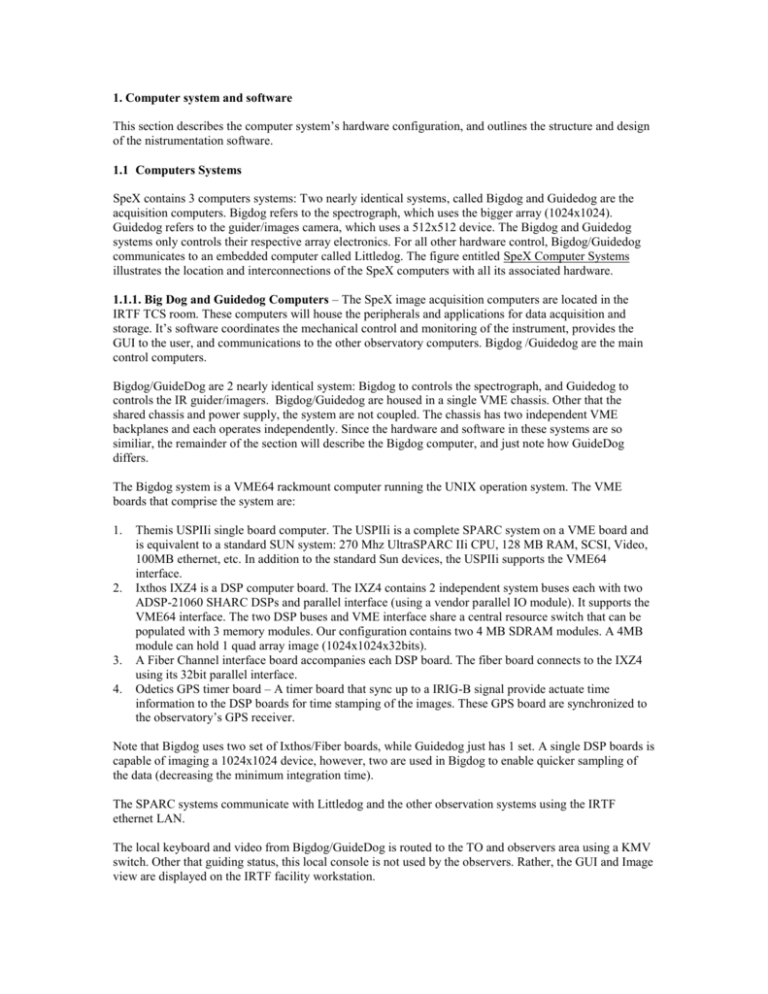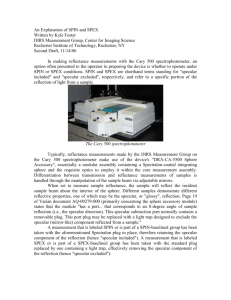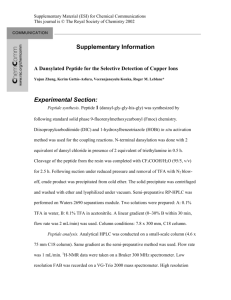1 Computer system and software
advertisement

1. Computer system and software This section describes the computer system’s hardware configuration, and outlines the structure and design of the nistrumentation software. 1.1 Computers Systems SpeX contains 3 computers systems: Two nearly identical systems, called Bigdog and Guidedog are the acquisition computers. Bigdog refers to the spectrograph, which uses the bigger array (1024x1024). Guidedog refers to the guider/images camera, which uses a 512x512 device. The Bigdog and Guidedog systems only controls their respective array electronics. For all other hardware control, Bigdog/Guidedog communicates to an embedded computer called Littledog. The figure entitled SpeX Computer Systems illustrates the location and interconnections of the SpeX computers with all its associated hardware. 1.1.1. Big Dog and Guidedog Computers – The SpeX image acquisition computers are located in the IRTF TCS room. These computers will house the peripherals and applications for data acquisition and storage. It’s software coordinates the mechanical control and monitoring of the instrument, provides the GUI to the user, and communications to the other observatory computers. Bigdog /Guidedog are the main control computers. Bigdog/GuideDog are 2 nearly identical system: Bigdog to controls the spectrograph, and Guidedog to controls the IR guider/imagers. Bigdog/Guidedog are housed in a single VME chassis. Other that the shared chassis and power supply, the system are not coupled. The chassis has two independent VME backplanes and each operates independently. Since the hardware and software in these systems are so similiar, the remainder of the section will describe the Bigdog computer, and just note how GuideDog differs. The Bigdog system is a VME64 rackmount computer running the UNIX operation system. The VME boards that comprise the system are: 1. 2. 3. 4. Themis USPIIi single board computer. The USPIIi is a complete SPARC system on a VME board and is equivalent to a standard SUN system: 270 Mhz UltraSPARC IIi CPU, 128 MB RAM, SCSI, Video, 100MB ethernet, etc. In addition to the standard Sun devices, the USPIIi supports the VME64 interface. Ixthos IXZ4 is a DSP computer board. The IXZ4 contains 2 independent system buses each with two ADSP-21060 SHARC DSPs and parallel interface (using a vendor parallel IO module). It supports the VME64 interface. The two DSP buses and VME interface share a central resource switch that can be populated with 3 memory modules. Our configuration contains two 4 MB SDRAM modules. A 4MB module can hold 1 quad array image (1024x1024x32bits). A Fiber Channel interface board accompanies each DSP board. The fiber board connects to the IXZ4 using its 32bit parallel interface. Odetics GPS timer board – A timer board that sync up to a IRIG-B signal provide actuate time information to the DSP boards for time stamping of the images. These GPS board are synchronized to the observatory’s GPS receiver. Note that Bigdog uses two set of Ixthos/Fiber boards, while Guidedog just has 1 set. A single DSP boards is capable of imaging a 1024x1024 device, however, two are used in Bigdog to enable quicker sampling of the data (decreasing the minimum integration time). The SPARC systems communicate with Littledog and the other observation systems using the IRTF ethernet LAN. The local keyboard and video from Bigdog/GuideDog is routed to the TO and observers area using a KMV switch. Other that guiding status, this local console is not used by the observers. Rather, the GUI and Image view are displayed on the IRTF facility workstation. 1.1.2 Little Dog Computer – Littledog is an embedded computer located at the telescope platform. It contains peripheral devices to enable SpeX to monitor / control any motors, sensors, analog or digital signals. Littledog is an i486/100mhz PIC/ISA computer with 24 MB RAM, 10MB ethernet, and an IDE harddisk. The Linux operating system, slackware distribution with the 2.2 kernel, is used. Littledog has the following peripherals board installed: 1. 2. 3. Cyclades 8 port serial board: 3 serial ports are used to communication to the Lake Shore temperature controller. 2 serial port are used to communication to Anamatics Smart Motor (servo motors). Oregon Microsystem’s PC-58 Intelligent Motion Controller. This board is used to control the 6 stepper motors used in SpeX. Industrial Computer Sources ADIO 1600 Analog & Digital IO board supports 16 analog input, 2 analog output, and 32 digital lines. This general purpose IO board enable use to monitor / control any analog or digitial IO. It is currently used to sample the hall-effect analog voltages. Littledog is located at the telescope platform near the instrument and associated electronic and controller. It communicated with the Bigdog/Guidedog using the telescope’s ethernet LAN. 1.1.3 Baytech RPC3 – The RPC3 is a network based AC power switch. Two are used: ‘hotdog’ is used to control power to the calibration lamps and calibration box shutter. The SpeX software has direct control of the hotdog RPC. Another RPC, power4, is used to control power to the Littledog PC, the temperature controllers, and array electronic. Power4 is normally controlled by the IRTF staff and is not used by SpeX software. 1.1.4 Facillity Workstation - The observers will display the SpeX GUI from a workstation located in the observer’s area. The GUI and image viewer is running inside the Bigdog/Guidedog system, but their windows are exported to the IRTF workstation. The IRTF observer’s workstation is configured with two 1280x1024 screens, allowing both the spectrograph and guider GUI to be display quite nicely. This workstation also provides network storage. We typical save the acquired images to this networked directory. 1.2 Software The SpeX instrumentation software can be broken down into 4 logical grouping: 1. 2. 3. 4. Instrument Control (IC) X User’s Interface (XUI) Quick-look data viewer (DV) Littledog control applications. Figure 1.2, software components and communication flow, illustrates the application and data / command flow in the system. 1.2.1 Instrument Control (IC) – The instrument Control application executes from the Bigdog/Guidedog computer. Its purpose is to run the command parser, data acquisition task, and to monitor the Littledog functions. The command parser takes user command (from the XUI) and executes them. Some commands are dispatched to the acquisition task, and some to Littledog. The acquisition task is responsible for controlling the DSP clocking and data acquisition functions. The DSPs are controlled by the acquisition task. When data is ready, the acquisition tasks assemble them into FITS image and saves them on to disk, and/or sents them to the data viewer (DV). A monitor task makes the Littledog status information available in the IC. A global shared memory allows all processes to easily access any of the SpeX information. The IC application is written in C. 1.2.2 X User Interface – The XUI is responsible for providing an easy-to-use interface to control the IC using various menu, button, and other software widget. It also provide a simple macro files execution dialog to allow more complex procedure to be build on the IC’s simple command set. The observers normally display the XUI on a remote X terminal. This X terminal is usually another workstation at the telescope, but it also can be remote machine. SpeX also allows multiple XUI to execute, the intend is to allow multiple group to used SpeX. For example, remote support by our staff, or participation of remote observers can be possible. The XUI is written in C and using GTK+ as it GUI widget library. 1.2.3 DV – DV is the IRTF quick look data view. It is a general-purpose FITS viewer, with some additional function to allow integration with the XUI/IC programs, and some custom modes for displaying SpeX data. DV can be used stand-alone FITS image viewer. The XUI is written in C and using GTK+ as it GUI widget library. 1.2.4 Little Dog Control application – There are a suite applications available on Littledog to initialize, set, and monitor the 8 motors and associated sensors, 3 temperature controller, RPC-3 power units. A Littledog RPC program allow the IC to use remote procedure calls to launch these various application, and to read back status information on all the devices. Device drivers for the PC-58 and AD1600 IO board were written. We also implemented RPC servers for each peripheral device, so we can monitor / control devices outside of SpeX software. For example, another computer can monitor the temperature controller status independently of SpeX. 1.3 Data Acquisition Mode This section describes the various data acquisition mode supported by the spex software: basic, slowguide, and the movies modes. 1.3.1 Basic – Basic mode is your fundamental imaging modes. A ‘GO’ just take a series of FITS images. The observers specify such parameters as integration time, co-add, telescope beaming pattern, subarray support, and cycles. Images are save to disk, and display on the DV windows. 1.3.2 Slow guide – Slow guide is a GuideDog only mode. In this mode, Guidedog continuously acquires images. In the SPARC host a guiding algorithm is applied to detect an offset changes in the images. These offsets can be transmitted to the TCS to correct telescope positioning. This mode is commonly used to keep an object inside the slit while taking spectra images using Bigdog. Various, centroid algorithm can be selected. These images can also be saved. 1.3.3 Big Movie and Guide Movie – Each instrument support a movie mode. The movie modes are designed to take a series of sub-array images and record them to disk. This mode is intended for occultation-type events where you wish to record a continuous stream of images, and minimize the gaps between images. It works by packing a series of frames in the DSP’s SRAM. When one SRAM module is full, the DSP switch SRAM modules. The SPARC host is notified of the switch and save the filled SRAM data to disk as a 3D FITS image. The duration of the movie is limited by available disk space. In the Bigdog, we limit the located of the sub-array to a single quadrant. .






